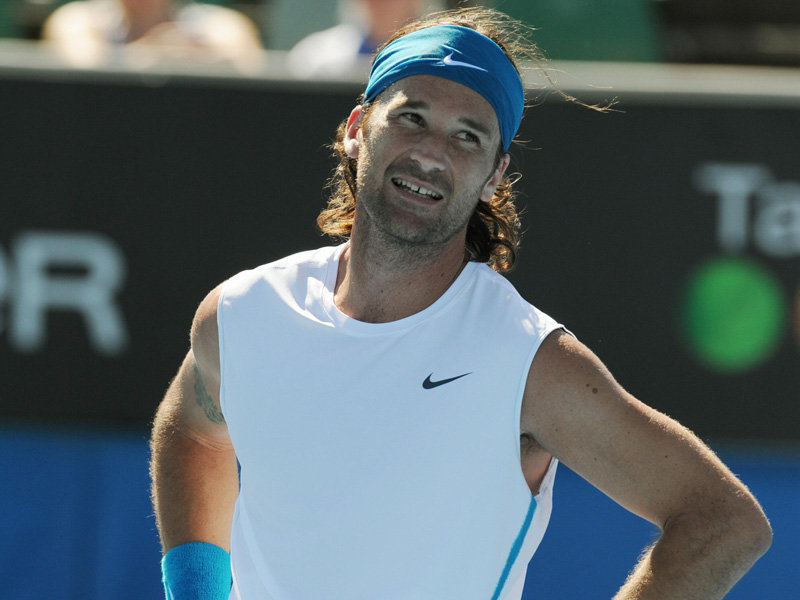Carlos Moya from Spain
When the word Mallorca roles off a tennis fan’s tongue, the immediate name that comes to mind is Rafael Nadal. The Spaniard has dominated the first part of his career by capturing nine Grand Slam titles, while continuing to chase all-time leader Roger Federer. But when looking back on the history of Spanish tennis, and more specifically tennis in Mallorca, it would be foolish for any fan or historian to cast aside the efforts of Carlos Moya.
The now 34-year-old, former No. 1 ranked player pulled the plug on his handsome career earlier today in his native Spain. Marred by injury throughout the past 18 months, Moya’s significant drop in the rankings, coupled by the birth of his first child, prompted his decision.
Capturing 20 titles in total, Moya began his journey toward the upper echelons of the sport by reaching the finals of the Australian Open in 1997. Clipping the likes of Boris Becker and Michael Chang along the way, Moya would lose a lopsided final to American Pete Sampras, but cemented himself as a new face on Tour.
Known as “Charlie” to his mates on the circuit, Moya’s rise and steady career were highlighted by his early-detached forehand and abbreviated serve. Gliding around the trendiest center courts around the globe, Moya’s insideout forehand style exemplified his gamestyle.
Entering his second Slam final at the French Open in 1998, Moya would face off against good friend and countryman Alex Corretja. Regardless of the camaraderie between the two, Moya’s tightly wound headband and kick serve out wide were ready for business. Rolling through the championship round in straight sets, Moya’s lone Grand Slam title wouldn’t define his career.
Growing up under the tutelage of Jose Perlas (the current coach of Nicolas Almagro), Moya’s future as a top flight professional was by no means a lockdown. Overshadowed by players such as Alberto Martin, Moya’s weaker backhand and calm demeanor weren’t exactly the recipe for Tour success. But as Moya’s talents began to develop, Perlas admitted that Moya’s calm and serene attitude would allow him to become a successful professional. In a day and age where players were manufactured and forced to play, Moya’s easy going island attitude allowed him to keep the necessary balance that so many of his peers failed to embrace.
Traveling with his trusty PlayStation console, Moya continued to find himself hovering around the top 10 for the better part of a decade. Winning three Masters 1000 events in total, Moya’s clay-court excellence also translated accordingly to the hard-courts in America. Experiencing great success at the Cincinnati event, Moya defeated Lleyton Hewitt for his biggest asphalt crown in 2002.
Moya’s grandest achievement, though, would take place during the 2004 Davis Cup final. Finding himself with many sleepless nights entering the home tie against the US, Moya dialed up his potent forehand to defeat Mardy Fish and Andy Roddick in singles action. Adding to his legacy by winning the country-inspired competition, Moya’s career was complete in many ways, even though he continued to compete.
Providing invaluable advice to a rising Nadal, Moya’s premonition of the talented youngster was spot on. Claiming that Nadal was the best player that he’d ever seen, Moya versed his countryman in the daily routines of a top athlete. There’s no question that a talent like Nadal in many ways can’t be taught or contained, but Moya’s influence and mentoring clearly gave the current world No. 1 a precise look into what his future would hold.
I enjoyed watching Moya’s game for many reasons. Reasons which revolved around his unbridled commitment to running around as many backhands as possible; to his exceptional sportsmanship and dolphin tattoo. I’ll always remember his backwards fall after he won in Paris, to the anguish on his face when he squandered a two-sets-to-love lead against Todd Martin at the US Open.
Although the Spaniard’s game would be hard to pull off in today’s era, his ability to check off every major accomplishment a tennis player could possibly achieve simply showcased both his mental and physical fortitude.
We have the pleasure as tennis fans to be apart of wonderful time in men’s tennis. Nadal and Federer have given us a fist full of lifetime memories, while the upcoming cast of Tour professionals continue to push the envelope of their physical limitations. But when we look back on the career of Carlos “Charlie” Moya, I think it’s more than fair that we salute the pioneer of Spanish tennis as the first man from Mallorca.
Something tells me that Nadal won’t mind at all.

















Classy send-off for a classy player, really enjoyed reading this bro; thanks for that.
His inside-out forehand was ridiculous:
http://www.youtube.com/watch?v=4lzWl1TZQzU